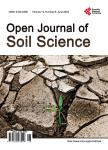Spatial Modeling of Soil Lime Requirements with Uncertainty Assessment Using Geostatistical Sequential Indicator Simulation
Spatial Modeling of Soil Lime Requirements with Uncertainty Assessment Using Geostatistical Sequential Indicator Simulation作者机构:INPE-Brazilian National Institute for Space Researches DPI-Divisão de Processamento de Imagens São José dos Campos Brazil Geopixel Soluções em Geotecnologias e TI São José dos Campos Brazil
出 版 物:《Open Journal of Soil Science》 (土壤科学期刊(英文))
年 卷 期:2017年第7卷第7期
页 面:133-148页
学科分类:1002[医学-临床医学] 100214[医学-肿瘤学] 10[医学]
主 题:Spatial Modeling of Soil Attributes Indicator Geostatistics Joint Simulation Principal Component Analyses Spatial Uncertainty Analyses
摘 要:This work presents and analyses a geostatistical methodology for spatial modelling of Soil Lime Requirements (SLR) considering punctual samples of Cation Exchange Capacity (CEC) and Base Saturation (BS) soil properties. Geostatistical Sequential Indicator Simulation is used to draw realizations from the joint uncertainty distributions of the CEC and the BS input variables. The joint distributions are accomplished applying the Principal Component Analyses (PCA) approach. The Monte Carlo method for handling error propagations is used to obtain realization values of the SLR model which are considered to compute and store statistics from the output uncertainty model. From these statistics, it is obtained predictions and uncertainty maps that represent the spatial variation of the output variable and the propagated uncertainty respectively. Therefore, the prediction map of the output model is qualified with uncertainty information that should be used on decision making activities related to the planning and management of environmental phenomena. The proposed methodology for SLR modelling presented in this article is illustrated using CEC and BS input sample sets obtained in a farm located in Ponta Grossa city, Paraná state, Brazil.



